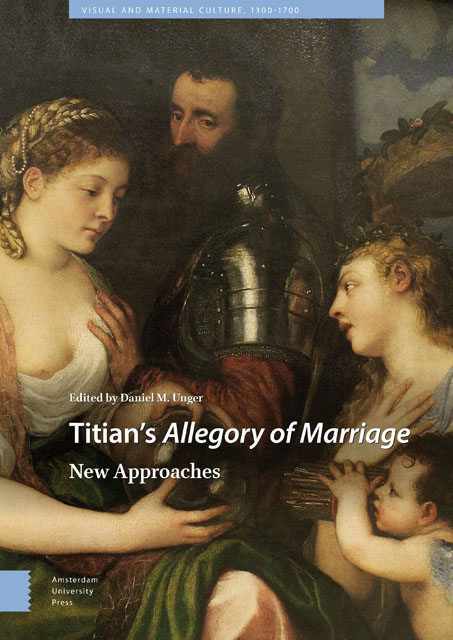Book contents
- Frontmatter
- Table of Contents
- List of Plates and Figures
- 1 Introduction: Poetic License
- 2 Love, Beauty, and the Human Body as a Reflection of the Divine
- 3 Amorosa visione: Titian’s Allegory of Marriage and the Poetry of the Half-length Format
- 4 The Arms and Armour of Titian’s Allegory of Marriage
- 5 ‘Un disio sol d’eterna gloria e fama’: A Literary Approach to Titian’s Allegory
- 6 Psyche, Venus, Ceres and Their Friends: Titian’s Remixes
- 7 Art and the Double Meaning of Reflection in Titian’s Allegory of Marriage
- 8 Titian’s Allegory of Marriage as an ‘Allegory of Peace’
- 9 Vision and Touch in the Allegory of Marriage
- 10 Of Crystal Orbs and Divinatory Mirrors : The Vicissitudes of Pregnancy and Artistic Agency in Titian’s Allegory of Marriage
- Index
3 - Amorosa visione: Titian’s Allegory of Marriage and the Poetry of the Half-length Format
Published online by Cambridge University Press: 16 November 2022
- Frontmatter
- Table of Contents
- List of Plates and Figures
- 1 Introduction: Poetic License
- 2 Love, Beauty, and the Human Body as a Reflection of the Divine
- 3 Amorosa visione: Titian’s Allegory of Marriage and the Poetry of the Half-length Format
- 4 The Arms and Armour of Titian’s Allegory of Marriage
- 5 ‘Un disio sol d’eterna gloria e fama’: A Literary Approach to Titian’s Allegory
- 6 Psyche, Venus, Ceres and Their Friends: Titian’s Remixes
- 7 Art and the Double Meaning of Reflection in Titian’s Allegory of Marriage
- 8 Titian’s Allegory of Marriage as an ‘Allegory of Peace’
- 9 Vision and Touch in the Allegory of Marriage
- 10 Of Crystal Orbs and Divinatory Mirrors : The Vicissitudes of Pregnancy and Artistic Agency in Titian’s Allegory of Marriage
- Index
Summary
Abstract
The Louvre Allegory of Marriage reframes the ‘amorous subjects’ of Titian's youth in light of the artist's maturation as the favoured portraitist to Emperor Charles V and the Italian and international military elite. In this chapter, I explore Titian's processes of pictorial invention within the constraints of the half-length format. The Allegory adapts a poetic of devotional representation rooted in well-established convergences of literary and pictorial practice. The Allegory's providentially recovered under-drawing allows for a superimposition of pictorial and critical narratives generated by the give-and-take between artist and painted object; between the latent and manifest protagonists in the painted fiction; and among the painter, his fictive personages, and the beholder drawn into an intimate exchange by the picture's abridged format.
Key Words: Invention, poetics, under-drawing, portraits of longing, Cupid-spiritello
Introduction
Writing to his royal patron Philip II in 1554, Titian first referred to his amorous mythologies as poesie. The term was not calculated simply to flatter a well-educated ruler, since the phrase from Horace's Ars poetica—ut pictura poesis (as is painting so is poetry)—had long passed into the repertory of commonplace expressions in the artist's workshop. If Titian's use of poesia was shorthand for the favola or mythological subject he depicted, it also inevitably referred to the manner of its making, its ‘poetics’ in the original sense of the Greek word poiesis. As the Ferrarese court writer and literary theorist Giambattista Giraldi Cinzio put it in his Discorso intorno al comporre dei romanzi (1549, published in 1554):
And perhaps the poet is so called above all because of this [making of fictions that induce maraviglia]. Because this name ‘poet’ means none other than ‘maker’ [questo nome di poeta non vuol dir altro che facitore]. And it is not for his verses but for his subjects [materie] first and foremost that he is called ‘poet’, inasmuch as they are made and feigned [fatte e finte] such that they are suited and appropriate to poetry [poesia].
By insisting that his materia favolosa, and not his use of verse-forms, is what makes the poet a ‘maker’, Cinzio conveniently ‘forgot’ that the very process of making is bound up with the artifice of versification (and much else), not to mention with the handling of pen and ink, the inscription of characters on parchment or paper.
- Type
- Chapter
- Information
- Titian's Allegory of MarriageNew Approaches, pp. 49 - 82Publisher: Amsterdam University PressPrint publication year: 2022



